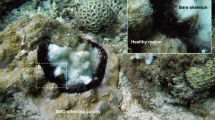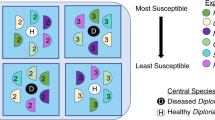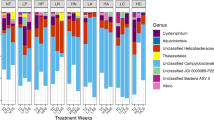Abstract
The global rise in coral diseases has severely impacted coral reef ecosystems, yet often little is known about these diseases, including how they are transmitted. White Band Disease (WBD), for example, has caused unparalleled declines in live Acropora cover, spreading rapidly throughout the Caribbean by unknown means. Here we test four putative modes of WBD transmission to the staghorn coral Acropora cervicornis: two animal vectors (Coralliophila abbreviata and C. caribaea) and waterborne transmission to intact and injured coral tissues. Using aquarium-based infection experiments, we determine that C. abbreviata, but not C. caribaea, acts as both a vector and reservoir for transmission of the WBD pathogen. We also demonstrate waterborne transmission to injured, but not intact staghorn coral tissues. The combination of transmission by both animal vectors and through the water column helps explain how WBD is spread locally and across the Caribbean.
Similar content being viewed by others
Introduction
Coral reefs have experienced unprecedented declines due to a global rise in disease epizootics over the last 30 years1,2,3. There are now more than 20 described coral diseases4, many of which are linked to increasing ocean temperatures and anthropogenic development5. Despite the negative impacts of these diseases, we often lack key information about their etiology and ecology6. Few coral pathogens have been identified and little is known about how most coral diseases are transmitted, making efforts to manage outbreaks difficult.
White Band Disease (WBD) is a prime example of a devastating coral disease that is poorly understood7,8,9. WBD is a host-specific disease that infects both Caribbean Acropora species7 – the staghorn coral Acropora cervicornis and the elkhorn coral A. palmata – and is identified by a progressing band of dying white tissue10. Since it was first reported in 197910, WBD has led to the destruction of up to 95% of Caribbean Acropora cover7,11 and resulted in the listing of both species as threatened under the US Endangered Species Act12 and as critically endangered on the IUCN Red List13. Transmission experiments using filtered homogenates to isolate bacteria combined with antibiotic treatments demonstrate that WBD is infectious and caused by bacteria14. While a specific WBD pathogen has not been isolated, Vibrio and Rickettsiales bacteria have both been associated with the disease8,9,15.
WBD is highly transmissible experimentally, either via direct contact between diseased and healthy corals16 or through application of gauze soaked in diseased tissue homogenate to a healthy coral14. Natural modes of transmission, however, are poorly understood. Two putative methods of WBD transmission are animal vectors and waterborne transmission. The corallivorous snail Coralliophila abbreviata is a vector for “rapid tissue loss” in A. cervicornis17. Other coral diseases can be transmitted through the water column18 and transmission can be enhanced by prior injury19,20.
Here we investigate the potential for WBD transmission via two putative snail vectors and the water column. First, we tested if C. abbreviata and C. caribaea (two common corallivorous snails found on A. cervicornis21) function as a vector and/or reservoir for WBD by exposing healthy A. cervicornis fragments to snails fed on healthy, diseased, or no corals (i.e. starved). Second, we tested the potential for waterborne transmission of WBD by adding diseased coral homogenates to closed-circuit aquaria containing intact and injured (i.e. lesioned) A. cervicornis fragments.
Results
When transmission was compared between C. abbreviata and C. caribaea, predation by C. abbreviata caused significantly higher rates of disease transmission (9 out of 19 fragments) than predation by C. caribaea, which failed to transmit WBD (Fisher's exact test, p = 0.0046; Table 1). In contrast, prior feeding treatments (healthy, diseased and starved) had no significant effect on WBD transmission rates by C. abbreviata (Fisher's exact test, p = 1; Table 1).
When WBD transmission was compared between C. abbreviata predation and lesion controls (mimicking predation), transmission was significantly higher in fragments fed on by C. abbreviata (21 out of 23) than lesion control fragments (1 out of 9) (Fisher's exact test, p < 0.001; Table 2). When fragments with WBD transmitted by C. abbreviata were grafted to healthy corals with lesions, 43 percent (4 out of 9) of the grafted fragments contracted WBD, demonstrating that WBD resulting from snail predation is transmissible by multiple means.
When waterborne transmission was tested, 6 out of 15 lesioned fragments inoculated with disease homogenate contracted WBD (Fisher's Exact test, p = 0.017; Table 3), while none of the intact (not lesioned) fragments inoculated with disease homogenate showed signs of WBD. No WBD was transmitted to fragments inoculated with a healthy homogenate.
Discussion
We tested four possible modes of White Band Disease transmission in A. cervicornis: predation by C. abbreviata, predation by C. caribaea, waterborne transmission to intact coral fragments and waterborne transmission to lesioned coral fragments. Transmission was highest in corals bitten by C. abbreviata, verifying that C. abbreviata acts as a vector for WBD. WBD was transmitted by C. abbreviata regardless of whether snails fed upon healthy corals, diseased corals, or were starved, indicating that C. abbreviata is able to retain the disease pathogen for at least two weeks and act as a reservoir for WBD. In contrast, C. caribaea did not transmit WBD to A. cervicornis, suggesting that not all corallivorous snails are capable of transmitting WBD. Waterborne WBD transmission only occurred when corals were injured (i.e. lesioned), indicating that tissue injury facilitates WBD transmission in corals.
Previous experiments by Williams and Miller17 show that C. abbreviata acts as a vector, but not a reservoir for “rapid tissue loss” in A. cervicornis. Their experiments differ from our results in that only snails that had fed on disease caused tissue loss. They did not test the possibility of the snails being a reservoir by starving their snails. Our results indicating that C. abbreviata acts as a reservoir for WBD is similar to the well-characterized Vibrio-Oculina disease system where the fireworm, Hermodice carunculata, acts as a vector and winter reservoir for the Vibrio shiloi bleaching pathogen on the Mediterranean coral Oculina patagonica22. WBD prevalence also varies seasonally and is highest in summer months (Libro and Vollmer, unpublished data). Thus, C. abbreviata may act like H. carunculata, and house the WBD pathogen during the winter and other periods of low WBD prevalence. Another corallivorous snail, Drupella cornus, has been associated with multiple coral diseases in the Indo-Pacific and Red Sea23,24, but no explicit tests of its potential as a vector or reservoir have been performed to our knowledge.
It is unclear why C. abbreviata, but not C. caribaea, can transmit WBD given that both are corallivores of A. cervicornis. Failure of C. caribaea to transmit WBD could be due to a combination of factors. Coralliophila caribaea consumed less coral tissue than C. abbreviata (unpublished data) and thus, may not have acquired enough pathogen for transmission or produced a large enough lesion on healthy corals to allow the pathogen to infect the coral. An alternate and potentially more interesting possibility is that C. caribaea is inhospitable to the WBD pathogen.
In terms of waterborne transmission, our data indicate that WBD is transmissible through the water column only if the coral has been injured (i.e. lesioned). The potential for injury and thus infection seems high given the many ways that tissue injury can occur in nature, including competition, mechanical damage, or corallivory by snails, damselfish, butterflyfish, fireworms and other taxa. Evidence for waterborne WBD transmission helps explain how WBD spread across the Caribbean since direct contact between healthy and diseased corals occurs between neighbors and C. abbreviata generally do not travel long-distances17.
Understanding the nature of WBD transmission provides insights into how the disease might be managed and controlled. While controlling waterborne WBD transmission will prove difficult, management of C. abbreviata populations may be a practical method of reducing WBD incidence, especially in heavily impacted Acropora populations. More research is needed to assess the viability of C. abbreviata population control as a management strategy, to identify the WBD pathogen and to understand pathogen dynamics within C. abbreviata.
Methods
Healthy and diseased (active WBD) A. cervicornis fragments (6 cm in length) and the snails C. abbreviata and C. caribaea were collected from Cayo Corales (9° 15′ 16″ N, 82° 7′ 40″ W) in Bocas del Toro, Panama in February 2012. Organisms were transported to the Smithsonian Tropical Research Institute in separate buckets. Coral fragments were cable-tied to plastic louver and acclimated in flow-through aquaria for three days prior to each experiment.
In order to test whether C. abbreviata and C. caribaea are capable of acting as a vector and reservoir for WBD, both species of snails were starved for three days and then randomly fed healthy A. cervicornis tissue (Healthy), diseased A. cervicornis tissue (WBD), or nothing (Starved) for three days. Snails were then placed in individual cages each containing one healthy coral fragment. Four cages were randomly placed into nine 500 L flow-through aquaria. Predation scars and WBD progression were measured (length x width) twice daily for five days. Once fragments exhibited signs of predation, the snails were removed from the cages. This allowed us to isolate predation (i.e. feeding) from disease progression.
A subsequent experiment was conducted to confirm that the WBD transmitted by C. abbreviata was not a response of the coral to mechanical damage. To do this, the first experiment was repeated with three cages containing one coral fragment and one C. abbreviata and one cage containing a coral fragment that had been experimentally lesioned by removing ∼7.5 mm2 of coral tissue with an airbrush and 0.2 μm filtered seawater (Figure 1d). WBD resulting from either snail predation or lesion controls was monitored as above. To confirm that WBD caused by C. abbreviata was due to a transmissible pathogen, fragments that had been fed on by C. abbreviata and contracted WBD were grafted to experimentally lesioned healthy corals and monitored.
To test waterborne WBD transmission, twelve replicate fragments of five genotypes were collected and placed in six closed-circuit 500 L aquaria containing a water circulation pump. Each aquarium contained two fragments of each of the five genotypes; one fragment per genotype was left intact and the other fragment was lesioned. Six fragments of healthy and six fragments of diseased A. cervicornis were individually vortexed in 50 mL plastic conical tubes filled with 15 mL 0.2 μm filtered seawater and 3 mm glass beads and combined to make our separate diseased and healthy inoculates. Aquaria were then randomly inoculated with either a diseased or healthy homogenate.
Transmission data comparing presence and absence of WBD in each experiment were analyzed using Fisher's exact tests25.
References
Harvell, C. D. et al. The rising tide of ocean diseases: unsolved problems and research priortities. Frontiers in Ecology and the Environment 2, 375–382 (2004).
Bourne, D. G. et al. Microbial disease and the coral holobiont. Trends in microbiology 17, 554–562, 10.1016/j.tim.2009.09.004 (2009).
Ward, J. & Lafferty, K. The elusive baseline of marine disease: are diseases in ocean ecosystems increasing? PLoS Biology 2, 542–547, 10.1371/journal.pbio.0020120.t001 (2004).
Sutherland, K., Porter, J. W. & Torres, C. Disease and immunity in Caribbean and Indo-Pacific zooxanthellate corals. Marine Ecology Progress Series 266, 273–302 (2004).
Harvell, C. D. et al. Emerging marine diseases: climate links and anthropogenic factors. Science 285, 1505–1510 (1999).
Lesser, M. P., Bythell, J. C., Gates, R. D., Johnstone, R. W. & Hoegh-Guldberg, O. Are infectious diseases really killing corals? Alternative interpretations of the experimental and ecological data. Journal of experimental marine biology and ecology 346, 36–44, 10.1016/j.jembe.2007.02.015 (2007).
Aronson, R. & Precht, W. White-band disease and the changing face of Caribbean coral reefs. Hydrobiologia 460, 25–38 (2001).
Gil-Agudelo, D., Smith, G. W. & Weil, E. The White Band Disease type II pathogen in Puerto Rico. International Journal of Tropical Biology 54, 59–67 (2006).
Ritchie, K. B. & Smith, G. W. Type II White-Band Disease. Reviews of Tropical Biology 46, 199–203 (1998).
Gladfelter, W. B. White-band disease in Acropora palmata: implications for the structure and growth of shallow reefs. Bulletin of Marine Science 32, 639–643 (1982).
Bythell, J., Gladfelter, E. & Bythell, M. Chronic and catastrophic natural mortality of three common Caribbean reef corals. Coral Reefs 12, 143–152 (1993).
Hogarth, W. in Federal Register Vol. 71 26853–26872. (2006).
Aronson, R., Bruckner, A., Moore, J., Precht, W. & Weil, E. IUCN Red List of Threatened Species, http://www.iucnredlist.org (2010).
Kline, D. I. & Vollmer, S. V. White Band Disease (type I) of Endangered Caribbean Acroporid Corals is Caused by Pathogenic Bacteria. Scientific Reports 1, 10.1038/srep00007 (2011).
Casas, V. et al. Widespread association of a Rickettsiales-like bacterium with reef-building corals. Environ Microbiol 6, 1137–1148, 10.1111/j.1462-2920.2004.00647.x (2004).
Vollmer, S. V. & Kline, D. I. Natural disease resistance in threatened staghorn corals. PLoS Biol 3, 1–5, 10.1371/journal.pone.0003718.g001 (2008).
Williams, D. & Miller, M. W. Coral disease outbreak: pattern, prevalence and transmission in Acropora cervicornis. Marine Ecology Progress Series 301, 119–128 (2005).
Zvuloni, A. et al. Spatio-temporal transmission patterns of Black-Band Disease in a coral community. PLoS Biology 4, 4993–4999, 10.1371/journal.pone.0004993.g001 (2008).
Aeby, G. & Santavy, D. L. Factors affeting susceptibility of the coral Montastraea faveolata to black-band disease. Marine Ecology Progress Series 318, 103–110 (2006).
Page, C. A. & Willis, B. L. Epidemiology of skeletal eroding band on the Great Barrier Reef and the role of injury in the initiation of this widespread coral disease. Coral Reefs 27, 257–272, 10.1007/s00338-007-0317-8 (2007).
Miller, A. Cnidarian prey of the snails Coralliophila abbreviata and C caribaea (Gastropoda: Muricidae) in Discovery Bay, Jamaica. Bulletin of Marine Science 31, 932–934 (1981).
Sussman, M., Loya, Y., Fine, M. & Rosenberg, E. The marine fireworm Hermodice carunculata is the winter reservior and spring-summer vector for the coral-bleaching pathogen Vibrio shiloi. Environmental Microbiology 5, 250–255 (2003).
Antonius, A. & Riegl, B. A possible link between coral diseases and a corallivorous snail (Drupella cornus) outbreak in the Red Sea. Atoll Research Bulletin 447 (1997).
Onton, K., Page, C. A., Wilson, S. K., Neale, S. & Armstrong, S. Distribution and drivers of coral disease at Ningaloo reef, Indian Ocean. Marine Ecology Progress Series, 10.3354/meps09156 (2011).
Sokal, R. R. & Rohlf, F. J. Biometry. 3 edn, (W.H. Freeman and Company, 1995).
Acknowledgements
We thank F. Aronson, N. Chu, E. Jones, E. Roberts, the Three Seas Program and the Smithsonian Tropical Research Institute for field and logistical support. Members of the Vollmer lab provided valuable comments. Grant funding was provided by the NSF Biological Oceanography program to SV (OCE 0751666). Collection permits were provided by Autoridad Nacional del Ambiente (ANAM#SE/A-1-12).
Author information
Authors and Affiliations
Contributions
SAGW, CJM and SVV designed the experiments. SAGW and CJM conducted the fieldwork, experiments and analyzed the data. SAGW, CJM and SVV co-wrote, reviewed and edited the manuscript.
Ethics declarations
Competing interests
The authors declare no competing financial interests.
Rights and permissions
This work is licensed under a Creative Commons Attribution-NonCommercial-NoDerivative Works 3.0 Unported License. To view a copy of this license, visit http://creativecommons.org/licenses/by-nc-nd/3.0/
About this article
Cite this article
Gignoux-Wolfsohn, S., Marks, C. & Vollmer, S. White Band Disease transmission in the threatened coral, Acropora cervicornis. Sci Rep 2, 804 (2012). https://doi.org/10.1038/srep00804
Received:
Accepted:
Published:
DOI: https://doi.org/10.1038/srep00804
This article is cited by
-
Acclimation period affects tissue condition in the Caribbean staghorn coral, Acropora cervicornis
Coral Reefs (2024)
-
Dynamics of Zooplankton-Mediated Disease Outbreak in Coral-reef
Differential Equations and Dynamical Systems (2023)
-
Mixtures of genotypes increase disease resistance in a coral nursery
Scientific Reports (2022)
-
The coral symbiont Candidatus Aquarickettsia is variably abundant in threatened Caribbean acroporids and transmitted horizontally
The ISME Journal (2022)
-
The role of predators in coral disease dynamics
Coral Reefs (2022)
Comments
By submitting a comment you agree to abide by our Terms and Community Guidelines. If you find something abusive or that does not comply with our terms or guidelines please flag it as inappropriate.




